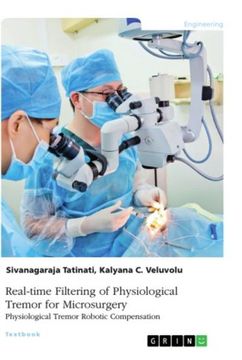Share
Real-time Filtering of Physiological Tremor for Microsurgery. Physiological Tremor Robotic Compensation (in English)
Kalyana Veluvolu
(Author)
·
Sivanagaraja Tatinati
(Author)
·
Grin Verlag
· Paperback
Real-time Filtering of Physiological Tremor for Microsurgery. Physiological Tremor Robotic Compensation (in English) - Veluvolu, Kalyana ; Tatinati, Sivanagaraja
$ 79.12
$ 98.90
You save: $ 19.78
Choose the list to add your product or create one New List
✓ Product added successfully to the Wishlist.
Go to My WishlistsIt will be shipped from our warehouse between
Wednesday, June 12 and
Thursday, June 13.
You will receive it anywhere in United States between 1 and 3 business days after shipment.
Synopsis "Real-time Filtering of Physiological Tremor for Microsurgery. Physiological Tremor Robotic Compensation (in English)"
Document from the year 2020 in the subject Engineering - Robotics, grade: 2, course: PhD, language: English, abstract: The work conducted in this dissertation focuses on issues that are related to the accurate and real-time separation of physiological tremor components from the sensed motion. This dissertation mainly focused on developing new algorithms and techniques for accurate modeling and prediction of physiological tremor components ( the filtering and modeling system) for the hand-held instruments. The methods developed in the course of this dissertation were validated with the physiological tremor database collected from micro-surgeons and novice subjects. Further, the methods were experimentally validated with the bench tests conducted on hand-held instrument, iTrem. Precision, robustness, dexterity, and intelligence are the design indices for current generation surgical robotics. In microsurgeries, physiological tremor - an intrinsic hand motion with amplitude of 100 m - is a major impediment for surgeons' to perform delicate and fine motor tasks in sub-millimeter space. To augment the required precision and dexterity into normal microsurgical workflow by compensating the tremor in real-time, hand-held robotic instruments are developed. The working principle of a typical handheld instrument involves subsequent execution of three steps 1) sensing its own motion with inertial sensors, 2) filtering the involuntary motion from the sensed motion, and 3) actuate the surgical end-effectors (instrument tip) based on the filtered involuntary motions to compensate the tremor motion. Generally, digital filters are employed to filter out the noise components and subsequently extract the tremor motion from the whole motion. As a result, a time-varying and unknown delay in the range of 20 to 200ms (depends on the variant of the filter) is introduced into the tremor compensation proceedings, which in turn, adversely affects the tremor compensation performance. Ide

